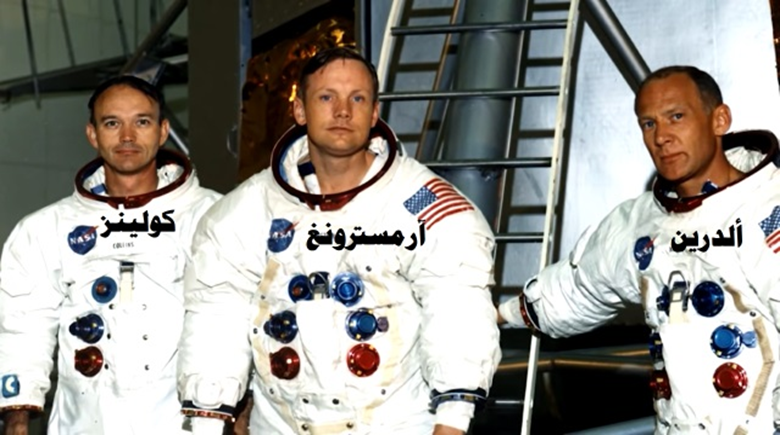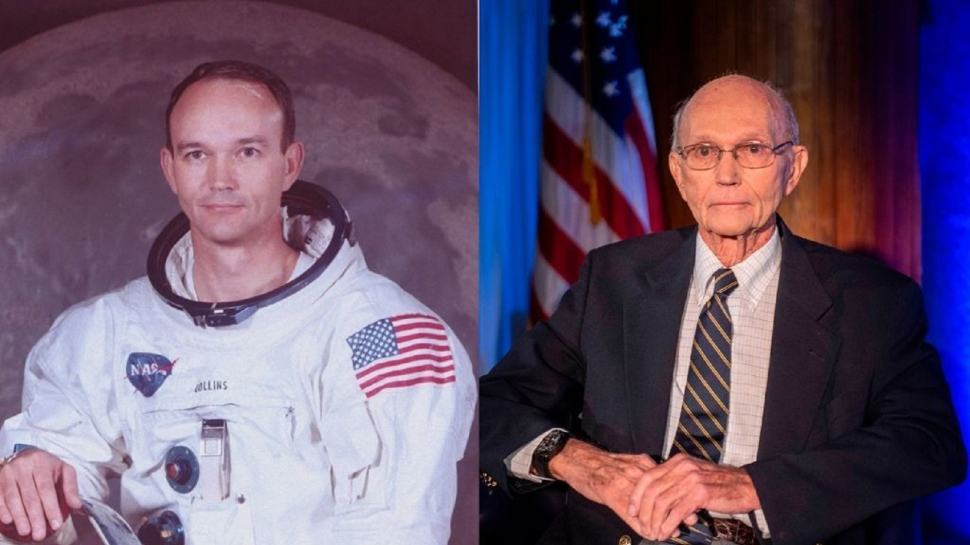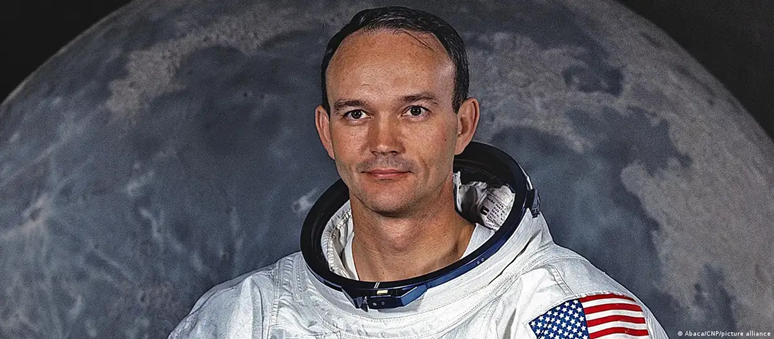Michael Collins, the forgotten astronaut of the “Apollo 11” mission

“What I remember most about that trip is the shape of the Earth when I saw it from a distance. It seemed so small and shiny, blue and white, bright and beautiful, calm and fragile.”
This is how astronaut Michael Collins saw it during the moments when he was in the spacecraft alone in the vicinity of the moon, while his two colleagues, Neil Armstrong and Buzz Aldrin, dismounted to take the first human steps on the surface of the moon in the summer of 1969.
He is Michael Collins, the astronaut who accompanied Armstrong on the famous Apollo mission, which witnessed the first human landing on the moon.

Mike Collins
In the moments when Armstrong was taking his glorious steps over the surface of the moon, Collins was alone in the spacecraft orbiting the moon, and some writings say that the moments of isolation that he lived at that time, especially when he was crossing the dark side of the moon, were the greatest moment. Isolation has been experienced by humans throughout history since Adam, peace be upon him. He was alone in an isolated spacecraft, far away from Earth.
This man finally died, which stirred some consciences that considered that he had not received his share of recognition and honor, and that he had become a symbol of that person who works in the shadows and whose name remains forgotten.
“I am completely satisfied with the role I played.” A forgotten man’s message
Michael Collins, the author of this experiment filled with scientific connotations and human feelings, passed away on April 28, 2021, at the age of ninety, leaving a collective pang of conscience that has affected all those who follow space science over the past decades, calling him “the forgotten” for what happened to him. It is a historical shame compared to his two colleagues who got off the spacecraft to explore the surface of the moon, while he remained inside it.
“Dear Mike, No matter where you are or going, you will always have the energy to brilliantly carry us to new heights. we will miss you. I hope you rest in peace.” This is how Buzz Aldrin, the third of the three astronauts who completed the Apollo 11 mission, mourned his friend Collins in a tweet on Twitter. Aldrin is the only one of them alive.
Despite his vital and decisive role in the arrival and safe return of his two other colleagues, Collins acknowledges his marginal seat, which he took out of the experience of the first human landing on the surface of the moon, as he says: I know that I would be lying or foolish if I said that I had the best of the three Apollo 11 seats. But I can say with all honesty and balance that I am completely satisfied with the role I played.
“It reminds our nation of the importance of cooperation in achieving goals.” The role of the shadow
48 minutes was the longest period that Collins spent in complete darkness that he crossed whenever his vehicle moved to the other side of the moon, where he could not see or hear anything. All his communications were cut off, while the light of the sun disappeared on the other side of the moon.

Suddenly... the wing of the spacecraft began to become clear to him thanks to the rays of the sun, just as the Earth was shining for him when he reached a position that allowed him to see the reflection of the sun's rays on its surface, thus immortalizing the scene in a wonderful way, while the moon seemed gray and rough to him as he circled it closely, and when The spacecraft regained contact with NASA, and Collins quickly told her that “the Eagle has landed.”
After ensuring communication between his two colleagues who were at that time on the moon's surface and the Earth, Collins listened to President Nixon's call as he congratulated the two astronauts enjoying their historic step on the moon's surface. Current US President Joe Biden says in a eulogy for Michael Collins: Collins may not have enjoyed the same glory as his two colleagues, but he is their equal partner, and he reminds our nation of the importance of cooperation in achieving great goals.

A photo taken by Michael Collins of the Eagle landing on the moon
The US Air Force...the beginning of flying into NASA space
Michael Collins was born on October 31, 1930, and he participated with his two colleagues in the Apollo 11 mission in the same year of birth. “Collins” saw the light in Italy, where his father was staying on an official mission as a major general in the US Army and attached to the American Embassy in Italy. After the outbreak of World War II, the family returned to Washington, so the child, “Michael”, enrolled in the classroom, and soon applied to one of the academies. He accepted the military service, fully determined to follow in his father’s footsteps in the military field, even though military service was a common denominator among the family members, as most of his uncles and brothers were also military personnel.
Collins began training to fly in 1952, and thanks to his demonstrated talent and excellence, he began training for the most complex and important tasks in the US Air Force, where he was in charge of testing jet fighters, and training on how to transport nuclear weapons.

His journey into space began when he joined the ranks of the US Army Air Forces at the end of the 1950s, where he worked in its ranks as a fighter pilot on probation at Edwards Base in California, between 1959-1963, a period during which he spent about 4,200 hours of flying, and was chosen by the US space agency NASA. “, on his second attempt after failing in the first, and he became a member of the crew that would undertake a space flight called “Gemini 10,” in July 1966, where he orbited the Earth 43 times as a training exercise, and exited the spacecraft for some time.
The crew of the historic Apollo 11 mission, 1969, and on the left is Michael Collins.
“Three young men on a legendary adventure.” Kennedy’s dream comes true
The decision to send a manned mission to the moon dates back to the year 1961. US President John Kennedy - in the context of the Cold War and the space race with the Soviet Union - decided to launch a special space program aimed at delivering the first human to the surface of the moon, and it is the program that will succeed in achieving this. The goal is after eight years, at a cost of approximately $24 billion.

President Kennedy was not destined to witness the fulfillment of this dream, but the Apollo 11 flight was launched from the Kennedy Space Center on Merritt Island, Florida, on the afternoon of July 16, 1969. The spacecraft was composed of three parts, and the first part would be abandoned. In the vicinity of the moon after the two astronauts used it to land on the surface of the moon and return from it, while the second part allocated to energy, oxygen and water was abandoned, so that the part dedicated to the command vehicle and the cabin of the three astronauts returned. The Saturn 5 rocket was behind providing the necessary propulsion to launch the spacecraft on its historic journey.
The Los Angeles Times wrote at the time, commenting on the trip: “Three young men on a legendary adventure, with human dimensions, and the whole world is invited to watch.” There was a spirit of adventure in the experience, as the three young men risked their lives to satisfy humanity's curiosity and eagerness to touch the surface of the moon.
These three people left their relatives for an adventure without taking risks. They were not even able to secure the future of their families, as they were unable to conclude an insurance contract covering the dangers of space. They came up with the idea of signing a large number of cards for their families to sell if they were unable to survive.
The Earth shines brightly from the surface of the Moon, with a size equivalent to four times the size of the Moon in the Earth’s sky.

Collins is isolated in space, waiting for the return of his two colleagues visiting the surface of the moon
The far side of the moon...the greatest isolation a human being has ever experienced
The “Apollo 11” experiment was the first successful experiment to touch the surface of the Moon, after the “Apollo 8” and “Apollo 10” experiments, which came very close to it. While Michael Collins was required to continue driving the spacecraft that provided the Apollo 11 flight, his colleagues Neil Armstrong and Buzz Aldrin were riding the special lander and landing it on the surface of the moon, minutes after eight o’clock in the evening on the same day. July 20, 1969.
After about six hours and forty minutes, Neil Armstrong was setting foot on the surface of the moon, before his colleague Aldrin joined him after about 20 minutes, to spend about two hours together outside their spacecraft, which the world watched at the time with great amazement, without anyone paying attention. To “Michael Collins,” who remained flying alone in the vicinity of the moon, waiting for his two colleagues to return to the “Columbia” spacecraft, which will ensure the team’s return to Earth with about 21 kilograms of dust and rocks captured from the surface of the moon.
Between the two astronauts’ departure from the “Columbia” spacecraft to the surface of the moon and their return to it, nearly a full day passed that “Michael Collins” spent in lunar orbit, a day that marks the greatest isolation a human being has ever experienced in history.
During his stay alone inside the spacecraft, flying in lunar orbit, Michael Collins was carrying on his shoulders the burden of making the dream of human habitation a success throughout the ages, and the habitation of Americans in particular since they entered into the feverish Cold War race with the Soviet Union over who would be the first to conquer space and achieve... The first breakthrough scientific achievement. The most difficult period of that journey was his transfer to the other side of the moon, as all his communications were cut off, whether with the NASA station on Earth or with his two colleagues on the surface of the moon.

The Earth shines brightly from the surface of the Moon, with a size equivalent to four times the size of the Moon in the Earth’s sky
Romantic moments of waiting... harsh hours and record numbers
The image that has remained ingrained in people's minds is the footage in which Neil Armstrong appears jumping over the surface of the moon while collecting samples, followed by Buzz Aldrin with the same jump. Nearly 650 million people watched these scenes on television, along with Collins, who was observing the situation from the moon’s orbit and enjoying the scenes he saw, which he later described as extremely romantic.
When he was asked about the most difficult moments he experienced during that trip, he said that it was the moment he was waiting for his two colleagues to return from the surface of the moon and dock them again with the vehicle in order to return to Earth. He was afraid that the engine of the special vehicle that his two colleagues used to land on the surface of the moon and then leave would break down, which is what happened. It meant they were stranded in a place where it was impossible to save them.
That flight achieved a record level of altitude in space, and successfully flew at an altitude of up to 766 kilometers, which constituted a birth certificate for an astronaut who would spend a total of 266 hours in space, before retiring from NASA in 1970, and then from the Air Force. American in 1982, with the rank of Major General.
As soon as he stopped flying high in space, Collins began many tasks in which he invested his expertise. He worked as Assistant Secretary of State and supervised the establishment of the National Air and Space Museum, which was officially opened in 1976.

Michael Collins became vice president of LTV Defense and Space in 1980, before setting up his own company in the mid-1980s. In addition to his scientific and consulting tasks, he also maintained his writing and authoring activity, as he published the book “Carrying the Fire” in 1974, then followed it two years later with the book “Flying to the Moon and Other Strange Places,” before returning in 1988 and publishing the book “The Takeoff... The Story of America’s Adventure in Space,” then the book “Mission to Mars,” which he published in 1990.
“I am now alone and completely isolated.” An obituary filled with remorse
Steve Gurchek, acting NASA administrator, mourned Michael Collins, saying: NASA is saddened by the loss of this accomplished pilot and astronaut, a friend of all who seek to exceed human potential. Whether his work was behind the scenes or in full view, his legacy will always be as one of the leaders who took America's first steps into the universe. His spirit will go with us as we head towards greater horizons.
And there, in the vicinity of the moon, “Michael Collins” was circumnavigating the moon at an altitude of 104 kilometers above the heads of his two colleagues charged with the mission of the first human landing on a planet other than Earth, and the eyes of the world were then turning to those immortal steps taken by “Neil Armstrong,” while he dived. Collins” deep in the darkness of oblivion.
Even when the three astronauts returned to Earth and celebrations began for those who had the opportunity to walk on the surface of the moon, those who took care of the spacecraft that would return the team to Earth were ignored. Even the plaque that was left on the surface of the moon with the message “We came in peace for the sake of all mankind” bore the signatures of “Armstrong,” “Aldrin,” and the US president at the time, “Richard Nixon.”
Collins says in describing the moments of complete isolation he lived in the vicinity of the moon, in his book “Carrying the Fire,” which he published in 1974: I am now alone, truly alone, and completely isolated from any known life.
Among the last things left behind by “Michael Collins” was a tweet he published in the year 2019: I truly believe that if the world’s political leaders were able to see their planet from a distance - let’s say 100 thousand miles -, their view would change radically.
Source: Al Jazeera Documentary - websites - Shahba Press

